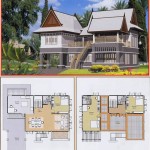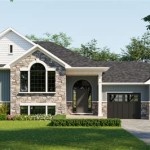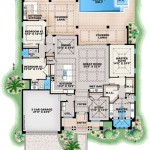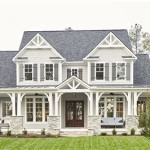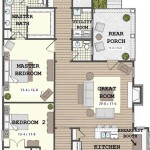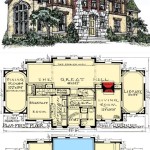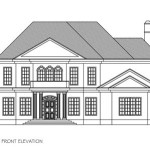House Plans: Designing a Residence Around a Large Kitchen
The kitchen has evolved from a purely utilitarian space into a central hub of the modern home. It is a location for meal preparation, family gatherings, casual dining, and even entertaining guests. Consequently, the design of a house plan frequently prioritizes the kitchen's size and layout. This article explores several key aspects of house plans that emphasize a large kitchen, focusing on design considerations, functional elements, and integration within the overall home layout.
A large kitchen offers numerous benefits, including increased counter space, ample storage, the potential for multiple workstations, and the ability to accommodate more occupants comfortably. However, designing such a space requires careful planning to ensure efficient workflow, aesthetic appeal, and seamless integration with the rest of the house. The size of the kitchen should be proportional to the overall size of the house. A disproportionately large kitchen in a smaller home can feel out of place, while an undersized kitchen in a large home may not meet the needs of the occupants.
Optimizing Kitchen Layout and Workflow
The layout of a large kitchen is crucial for maximizing efficiency and minimizing unnecessary movement. Several common kitchen layouts are well-suited for larger spaces, including the island, peninsula, U-shaped, and L-shaped configurations. Each of these layouts offers distinct advantages in terms of workspace, storage, and traffic flow.
The island kitchen layout is a popular choice for large kitchens. It typically features a central island that provides additional counter space, storage, and a focal point for the room. The island can be utilized for food preparation, casual dining, or even as a social gathering area. The placement of the island is critical, ensuring adequate clearance around it for comfortable movement. A distance of at least 42 inches is recommended between the island and surrounding countertops or appliances.
Peninsula kitchens are similar to island kitchens but feature a connected counter extending from a wall or cabinet run. This peninsula offers similar benefits to an island, such as additional counter space and seating, but it can also serve as a visual barrier, separating the kitchen from an adjacent room. This layout is often suitable for open-concept floor plans where a degree of separation is desired.
U-shaped kitchens maximize counter space and storage by utilizing three walls. This layout is particularly efficient for single-cook kitchens but can also accommodate multiple users. The key to a successful U-shaped kitchen is ensuring that the distance between the opposing countertop runs is adequate for comfortable movement, typically between 5 and 8 feet.
L-shaped kitchens utilize two walls, offering a flexible and efficient layout for a variety of kitchen sizes. In larger kitchens, the L-shape can be extended with an island or peninsula to create a more expansive and functional workspace. This layout is well-suited for open-concept designs, allowing the kitchen to flow seamlessly into adjacent living areas.
Regardless of the chosen layout, the work triangle principle should be considered. This principle emphasizes the relationship between the sink, refrigerator, and cooktop, aiming to minimize travel distance between these key work areas. While the work triangle has evolved over time, the fundamental concept of efficient workflow remains relevant in modern kitchen design.
Incorporating Functional Elements and Storage Solutions
A large kitchen provides ample opportunity to incorporate a variety of functional elements and storage solutions. These elements can enhance usability, organization, and overall aesthetic appeal. Considerations include specialized appliances, pantry configurations, and customized storage options.
Specialized appliances can significantly enhance the functionality of a large kitchen. These might include a double oven, a warming drawer, a built-in coffee maker, or a separate prep sink. The selection of appliances should be based on the homeowner's cooking habits and preferences. Careful planning is essential to ensure that these appliances are properly integrated into the kitchen design and have adequate electrical and plumbing provisions.
Pantry storage is a critical element in any large kitchen. A walk-in pantry offers the most storage space and allows for easy organization. However, a well-designed reach-in pantry with pull-out shelves and adjustable storage can also be highly efficient. The pantry should be located close to the main work area of the kitchen for convenient access to ingredients and supplies. Thoughtful organization within the pantry is important for maximizing storage capacity and minimizing food waste.
Customized storage options can further enhance the functionality of a large kitchen. These options might include pull-out spice racks, drawer organizers, and vertical dividers for baking sheets and cutting boards. Corner cabinet solutions, such as lazy Susans or pull-out shelves, can maximize the use of otherwise inaccessible space. Incorporating these customized storage solutions can help to keep the kitchen organized and efficient.
Beyond cabinetry, consider the placement and type of lighting. Layered lighting, including ambient, task, and accent lighting, is crucial for creating a well-lit and functional kitchen. Recessed lighting provides general illumination, while under-cabinet lighting illuminates the countertops for food preparation. Pendant lights over the island or peninsula can add a decorative touch and provide focused lighting for dining or socializing. Natural light is also highly desirable in a kitchen, so incorporating large windows or skylights should be considered.
Integrating the Kitchen into the Overall House Plan
A large kitchen should be seamlessly integrated into the overall house plan to create a cohesive and functional living space. This integration involves considering the kitchen's relationship to adjacent rooms, traffic patterns, and the overall style of the house.
Open-concept floor plans are a popular choice for homes with large kitchens. These plans typically combine the kitchen, dining area, and living room into a single, unified space. This arrangement promotes social interaction and provides a sense of spaciousness. However, it also requires careful consideration of noise levels and visual harmony. Soundproofing measures, such as insulated walls and sound-absorbing materials, may be necessary to minimize noise transmission between the kitchen and living areas. The design elements of the kitchen, dining area, and living room should be coordinated to create a cohesive and visually appealing space. This includes selecting complementary colors, materials, and furniture styles.
Even if a fully open-concept plan isn't desired, the kitchen's adjacency to the dining area is paramount. Easy access between the kitchen and dining room simplifies meal service and encourages family interaction. A pass-through window or a wide doorway can facilitate this connection while still providing some degree of separation between the two spaces. Consider the flow of traffic between the kitchen and other areas of the house. The kitchen is often a high-traffic area, especially during meal preparation and family gatherings. Ensuring that traffic patterns do not interfere with the kitchen's workflow is important for safety and efficiency.
The style of the kitchen should complement the overall style of the house. A modern kitchen with sleek lines and minimalist design might be appropriate for a contemporary home, while a traditional kitchen with ornate details and rich wood finishes might be better suited for a more formal residence. Selecting materials, finishes, and appliances that are consistent with the overall style of the house will create a cohesive and harmonious design.
Furthermore, consider the placement of the kitchen in relation to outdoor spaces. A kitchen that opens onto a patio or deck can extend the living space and create a seamless transition between indoor and outdoor activities. This connection is particularly desirable for those who enjoy outdoor cooking and entertaining. Incorporating a large window or sliding glass door can provide natural light and ventilation while also offering views of the outdoor space.
The design of a house plan that emphasizes a large kitchen requires a comprehensive approach, taking into account layout, functionality, and integration with the overall home. Careful planning and attention to detail are essential for creating a kitchen that is both beautiful and functional, serving as the heart of the home for years to come.

Nice Large Kitchen House Plans Floor Ranch

Trending House Plans With Large Kitchens Houseplans Blog Com

Trending House Plans With Large Kitchens Houseplans Blog Com

Trending House Plans With Large Kitchens Houseplans Blog Com

Hattiesburg Kabel

Cottages Small House Plans With Big Features Blog Homeplans Com

Kitchen Floor Plan Plans With Island The House Designers

A Simple One Story House Plan With Two Master Wics Big Kitchen Island Covered Porch Jack Traditional Plans European

House Plan 4 Bedrooms 2 5 Bathrooms Garage 3868 Drummond Plans

4 Bedroom House Plan Examples

